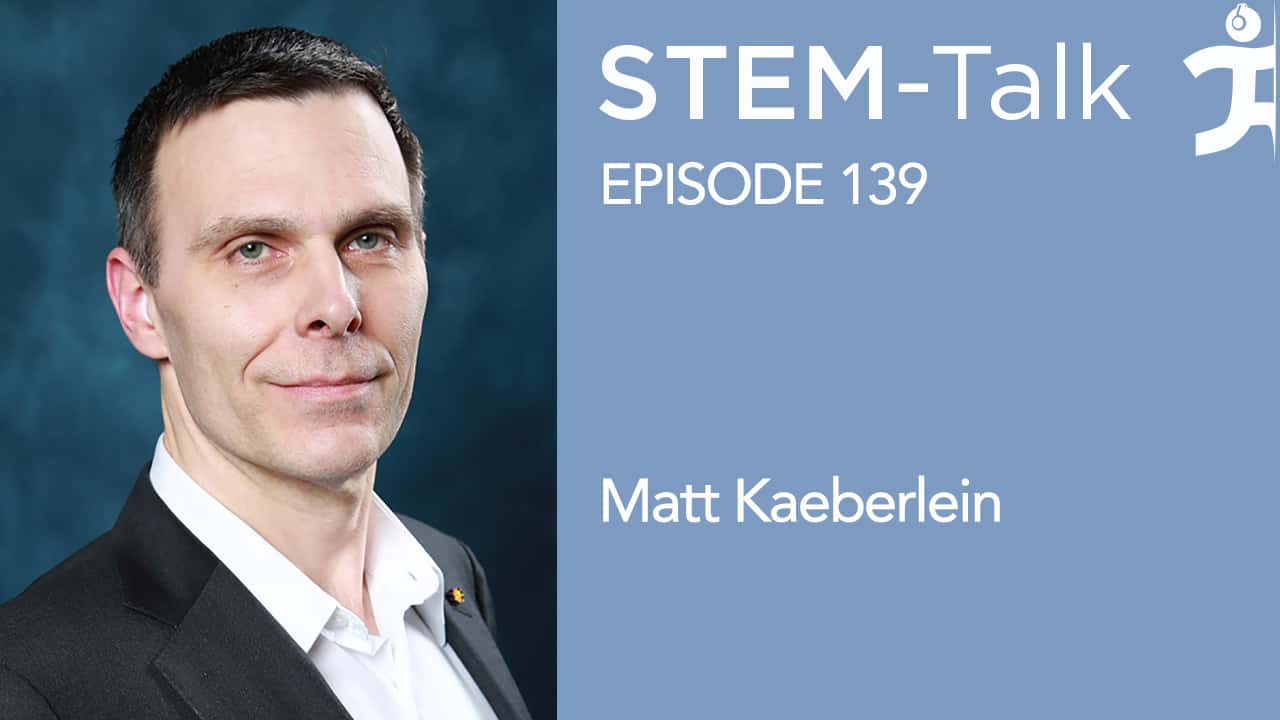STEM-Talk
Episode 139: Matt Kaeberlein discusses healthspan, longevity, and rapamycin
// Jul 25, 2022

In response to several requests from listeners, we have as our guest today, Dr. Matt Kaeberlein, a professor of pathology at the University of Washington. Matt is well-known for his investigations into the basic mechanisms of aging. Much of his research in this area is focused on identifying interventions that promote healthspan and lifespan.
In today’s interview, we talk to Matt about the biology of aging and what he has learned about slowing the aging process. In 1999, Matt and his colleague Mitch McVey discovered that overexpression of the SIR2 gene is sufficient to extend lifespan in yeast. SIR stands for silent information regulator, and we have an interesting discussion about how Matt’s research and 1999 discovery have elevated SIR2 to the forefront of aging research.
Also, some of Matt’s most recent and fascinating investigations have been into rapamycin, the only known pharmacological agent to extend lifespan. His research has shed new light on the role rapamycin plays in delaying age-related dysfunction in rodents, dogs, and humans.
We also have a fun discussion with Matt about his research showing that rapamycin may have the potential to reduce the mortality of companion dogs. The paper that came out of this research landed Matt on the front page of the New York Times and received prominent play in the national and overseas media.
Other topics we cover include:
- Matt’s attempts to uncover the molecular mechanism behind lifespan extension via calorie restriction.
- His research into mTOR, which is a protein in every cell, and how inhibiting mTOR has been shown to extend the lifespan of insects, rodents, and animals.
- Matt’s 2006 study that showed fasting extends lifespan in worms more than caloric restriction.
- And an article Matt published last year that summarized several of the most popular anti-aging diets, comparing them with classical caloric restriction.
In addition to his work in his Kaeberlein Lab, Matt is the co-director of the Nathan Shock Center of Excellence in the Basic Biology of Aging and the founding director of the Healthy Aging and Longevity Research Institute at the University of Washington. He also is the founder and co-director of the Dog Aging Project.
Show notes:
[00:02:53] Dawn asks Matt and his youth and where he grew up. [00:03:06] Ken asks if it is true that Matt spent a good deal of his youth “up to no good.” [00:04:20] Dawn mentions that while Matt got decent grades in school, it wasn’t until he went to college that he became studious. Dawn asks Matt if it true that he had originally decided to skip college. [00:05:42] Dawn asks how Matt ended up in Bellingham at Western Washington. [00:06:41] Dawn asks how in the world, despite not liking high school and working a morning shift at UPS for two years after graduating, Matt decided to head off for college and major in biochemistry of all things. [00:08:01] Ken asks what led Matt to travel across the country to Boston and MIT’s biology program. [00:09:57] Ken asks why Matt decided to focus his research on the biology of aging. [00:11:57] Matt talks about what he did following his Ph.D. [00:13:15] Dawn asks Matt what kind of research he did at the University of Washington Department of Genome Sciences for his post-doc, and how this research related to aging. [00:15:10] Ken mentions that it was during Matt’s undergrad that he decided to focus on the question, “To what extent are the mechanisms of aging evolutionarily conserved?” Ken asks Matt what caused him to arrive at that for his central focus. [00:19:36] Dawn mentions that the discovery by Matt, and Mitch McVey, that overexpression of SIR2 (Silent Information Regulator) is sufficient to extend life span in yeast is credited with promoting SIR2 to the forefront of aging research. Dawn goes on to mention that SIR genes are determinants of life span in yeast mother cells. Dawn asks Matt to give a quick primer on the SIR genes and their functions. [00:20:55] Ken follows up asking about Matt’s 1999 paper that appeared in the journal Genes and Development. Matt talks about this paper and how he demonstrated that increasing the dosage of SIR2 extended lifespan. [00:23:42] Dawn mentions that after Matt arrived at the University of Washington, he began looking at yeast and C. elegans, to see if there were key aspects of aging that could be related to humans. This research led to Matt and his colleagues publishing a paper in 2008 demonstrating quantitative evidence for conserved longevity pathways between different eukaryotic species. Dawn asks Matt to talk about how today most people agree that there are key aspects of aging shared across all animals, even down to yeast. [00:27:27] Dawn asks about Matt’s lab and the work he does at the University of Washington as well as the work he does as the director of the Healthy Aging and Longevity Research Institute as well as the work he does as director of the Nathan Shock Center of Excellence in the Basic Biology of Aging Training Program. [00:30:06] Dawn asks about some papers Matt published in 2004 and 2005, which attempted to uncover the molecular mechanism behind lifespan extension via calorie restriction, which has been seen across a wide variety of animals. Dawn mentions that one of Matt’s 2004 papers disproved the model that caloric restriction acts solely through SIR2 to mediate lifespan extension and asks him to talk about that discovery. [00:36:31] Ken follows up asking Matt to talk more about his TOR and mTOR related work. [00:39:57] Dawn mentions that Matt’s lab followed up these aforementioned papers with a study that showed fasting extends lifespan in worms more than caloric restriction, in which the worms were fasted for their entire adulthood. Matt talks about the findings and implications of this study. [00:43:41] Ken asks about Matt’s research into rapamycin and the role it plays in increasing the lifespan of rodents and delays age-related dysfunction in both rodents and humans. Ken asks specifically about Matt’s 2016 study, the findings of which suggest that short-term rapamycin treatment late in life can not only delay aging but also influence cancer prevalence and modulate the microbiome. [00:47:43] Dawn mentions Matt’s research that garnered the attention of the NY Times, where he began treating dogs with rapamycin and asks what prompted Matt’s interest in studying dogs and aging. [00:51:06] Ken mentions Matt’s article in Nature published earlier this year, where he explained that the primary goal of the Dog Aging Project is to generate and facilitate discoveries on the fundamental biology of aging. He also argued that the impact of the Dog-Aging Project will go far beyond this goal and Ken asks Matt to explain what he meant by that. [00:53:46] Dawn asks about Matt’s recent paper in eLife that looked at whether rapamycin could rejuvenate oral health in mice, and goes on to explain that periodontal disease is prevalent in elderly human populations and currently has no therapy that can effectively reverse it. Matt talks about this study and the promising results from it. [00:56:21] Dawn asks about Matt’s recent review summary that appeared in the journal Science last year that looked at several of the most popular anti-aging diets, comparing them with classical caloric restriction. Matt gives an overview of the interventions evaluated and what insights were gained. [01:01:38] Ken mentions that IHMC has done some studies on ketone esters and asks about Matt’s opinion on findings that suggest that ketone esters by themselves could have antiaging properties. [01:04:59] Ken asks about Matt’s opinion that a case can be made that mTOR complex 1 is a particularly relevant and robust molecular transducer of diet-induced antiaging signals. [01:08:41] Ken asks if mTOR complex 1 is the complex that is involved in muscle protein synthesis. [01:11:31] Ken brings up the point that discussions of mTOR inhibition via rapamycin is often coupled with the idea of inhibition of protein synthesis which leads to confusion regarding the difference between not having enough protein in the diet and inhibiting protein synthesis. Matt brings up the point that transient inhibition of mTOR will have different effects than continued chronic inhibition of mTOR, making dosing and timing important variables in this question. [01:13:08] Ken and Matt discuss the self-experimentation that many people have begun to do with rapamycin. They also discuss the possible interaction of rapamycin and resistance exercise in humans. [01:14:58] Ken asks, based on all the current findings regarding rapamycin, whether Matt thinks we are at the point where people should start seriously considering rapamycin or if more research needs to be done first. [01:17:55] Ken asks if Matt has perceived a benefit from his own personal use of rapamycin. [01:20:06] Dawn asks Matt, as someone who lives by the motto “live long or die trying,” what are the strategies that he uses in terms of diet, supplements, and exercise. [01:23:46] Dawn asks Matt how his dog is doing to close the interview.Links:






